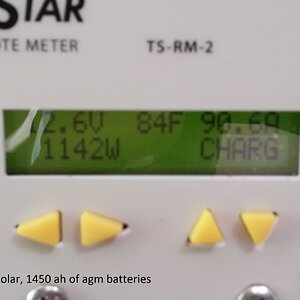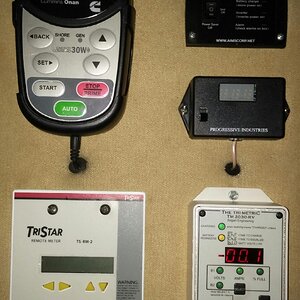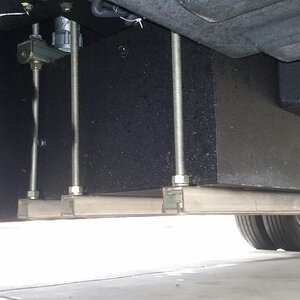turbopilot
RVF Supporter
- Joined
- Nov 2, 2019
- Messages
- 690
- Location
- Prescott, AZ
- RV Year
- 2026
- RV Make
- LightShip
- RV Model
- AE.1 Cosmos
- RV Length
- 26
- Engine
- Electric
- TOW/TOAD
- 2025 Ford F-150 PowerBoost HEV
- Fulltimer
- No
Looking at all the reported efficiency information so far at highway towing speeds (around 62 MPH), efficiency for any tow vehicle can be thought of in quartiles when towing a LightShip. Towing a slab sided high profile trailer reduces tow vehicle efficiency by about 50% compared to the efficiency seen in the tow vehicle not towing. Pulling a LightShip with TrekDrive OFF you can expect about 75% of the non-towing tow vehicle efficiency. Towing the LightShip with TrekDrive ON you can expect 100% of the tow vehicle efficiency when not towing.
I currently tow an Airstream. Owing to the aerodynamic profile of the Airstream I normally see around 60% of the non-towing efficiency of my F-150 PowerBoost.
This rule of thumb works pretty well for any tow vehicle type: EV, HEV or ICE.
Cruising at higher highway speeds will give a much more dramatic improvement comparing the LightShip to a slab sided trailer as you get in impact of "velocity squared" working in the drag equation.
Correcting some misinformation posted earlier the LightShip coefficient of drag is .23 (roughly the same as a Tesla Model 3), while the Airstream coefficient of drag is .58. Both of these drag coefficients are for the trailer in tow following in the wake of a tow vehicle.
Here is Grok's explanation:
OverviewThe coefficient of drag (Cd) is a dimensionless measure of a vehicle's aerodynamic resistance to airflow, where lower values indicate better efficiency (less drag). For towable RVs, Cd is often evaluated for the trailer alone or the tow vehicle-trailer combination, as the trailer's shape significantly affects overall towing efficiency, especially at highway speeds. The LightShip AE.1 is a modern, all-electric travel trailer designed with advanced aerodynamics, including a telescoping "Dual Mode" body that lowers for travel to minimize drag. Airstream towables, iconic for their teardrop shape, are also relatively aerodynamic compared to boxy competitors but rely on traditional aluminum construction without active drag-reduction features.Based on available data, the LightShip AE.1 demonstrates superior aerodynamics, with a Cd comparable to high-efficiency sedans. Airstream models have higher Cd values, though they outperform many conventional RV.
Key Comparison
Analysis
I currently tow an Airstream. Owing to the aerodynamic profile of the Airstream I normally see around 60% of the non-towing efficiency of my F-150 PowerBoost.
This rule of thumb works pretty well for any tow vehicle type: EV, HEV or ICE.
Cruising at higher highway speeds will give a much more dramatic improvement comparing the LightShip to a slab sided trailer as you get in impact of "velocity squared" working in the drag equation.
Correcting some misinformation posted earlier the LightShip coefficient of drag is .23 (roughly the same as a Tesla Model 3), while the Airstream coefficient of drag is .58. Both of these drag coefficients are for the trailer in tow following in the wake of a tow vehicle.
Here is Grok's explanation:
OverviewThe coefficient of drag (Cd) is a dimensionless measure of a vehicle's aerodynamic resistance to airflow, where lower values indicate better efficiency (less drag). For towable RVs, Cd is often evaluated for the trailer alone or the tow vehicle-trailer combination, as the trailer's shape significantly affects overall towing efficiency, especially at highway speeds. The LightShip AE.1 is a modern, all-electric travel trailer designed with advanced aerodynamics, including a telescoping "Dual Mode" body that lowers for travel to minimize drag. Airstream towables, iconic for their teardrop shape, are also relatively aerodynamic compared to boxy competitors but rely on traditional aluminum construction without active drag-reduction features.Based on available data, the LightShip AE.1 demonstrates superior aerodynamics, with a Cd comparable to high-efficiency sedans. Airstream models have higher Cd values, though they outperform many conventional RV.
Key Comparison
| Aspect | LightShip AE.1 | Airstream Towable (e.g., Sport Models) |
|---|---|---|
| Reported Cd | ≈0.23 (for tow vehicle-trailer combo; on par with Tesla Model 3 sedan) | 0.58 (for 16-22 ft Sport models; typical range 0.3–0.6 across models) |
| Design Features | Telescoping roof lowers frontal height by ~35-40% in "Road Mode," smooth leading edges, integrated TrekDrive motors to assist propulsion and reduce effective drag. | Iconic rounded "silver bullet" shape reduces drag by ~25% vs. boxy competitors (e.g., 28-ft model vs. 35-ft rival), but fixed height limits optimization. |
| Efficiency Impact | Enables near-zero range loss when towing with EVs; <250 Wh/mi energy use in combo. 3x more aerodynamic than typical trailers. | Improves fuel economy vs. non-aero RVs but adds significant drag (e.g., 43% reduction in tow vehicle Cd when paired optimally). |
| Sources | Forum analysis citing design specs ; LightShip claims . | Airstream Forums calculation ; typical range from comparative analysis ; wind tunnel tests . |
Analysis
- LightShip AE.1 Advantage: Its Cd of ~0.23 is roughly 40-60% lower than Airstream's, translating to substantial savings in fuel/charge consumption during towing. This is achieved through automotive-inspired CFD (computational fluid dynamics) optimization, making it ideal for EV towing where range anxiety is a concern.
- Airstream Strengths: While higher in Cd, Airstream's design still yields 25% less total drag (CDA, which factors in frontal area) than many larger, boxier trailers . For a comparable ~25-ft model, expect 20-50% more drag than the LightShip.
- Caveats: Cd values can vary by test conditions (e.g., wind, speed, combo setup). LightShip data is often for the integrated system; isolated trailer Cd may differ slightly. Airstream's figures are model-specific and from user/forums analyses, as official Cd isn't always published.
Last edited:












